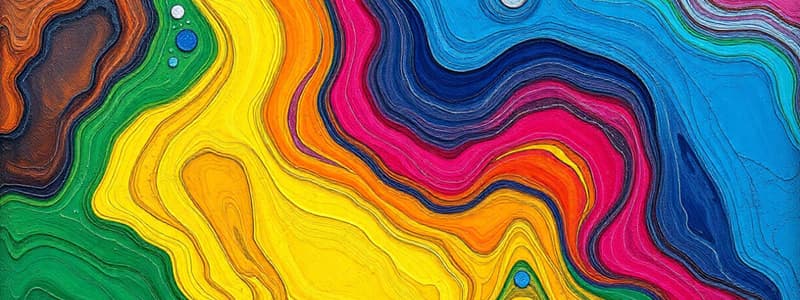Podcast
Questions and Answers
Which of the following best describes the relationship between the Earth's compositional layers and mechanical layers?
Which of the following best describes the relationship between the Earth's compositional layers and mechanical layers?
- The compositional layers are defined by their physical state (solid, liquid, gas) whereas the mechanical layers are defined by the processes that occur in them. (correct)
- There is no relationship between compositional layers and mechanical layers; they are independent systems with different properties and functions.
- The mechanical layers are strictly defined by their chemical makeup, and the compositional layers are defined by the motion they exhibit.
- The compositional layers directly dictate the activity within the mechanical layers, with specific materials causing specific actions.
Which of the following statements accurately contrasts a divergent boundary with a convergent boundary?
Which of the following statements accurately contrasts a divergent boundary with a convergent boundary?
- Divergent boundaries involve plates colliding, while convergent boundaries involve plates sliding past each other.
- Divergent boundaries create new crust, while convergent boundaries recycle old crust. (correct)
- Divergent boundaries cause only earthquakes, while convergent boundaries cause only volcanic activity.
- Divergent boundaries are characterized by subduction zones, while convergent boundaries are characterized by mid-ocean ridges.
Which statement best explains the role of convection currents in plate tectonics?
Which statement best explains the role of convection currents in plate tectonics?
- Convection currents in the mantle are primarily driven by gravitational forces and cause the plates to move.
- Convection currents within the asthenosphere, driven by heat from the Earth's core, transfer heat and induce plate movement. (correct)
- Convection currents are a minor force in plate tectonics, with radioactive decay being the primary driving force.
- Convection currents occur only within the lithosphere and cause localized volcanic activity.
Tectonic uplift, faulting, and folding are all processes contributing to the formation of what?
Tectonic uplift, faulting, and folding are all processes contributing to the formation of what?
Which sequence correctly orders the four major geologic eras from the oldest to the most recent?
Which sequence correctly orders the four major geologic eras from the oldest to the most recent?
Flashcards
Biotic System
Biotic System
A system made up of living things, such as plants and animals.
Lithosphere
Lithosphere
The Earth's outermost solid layer, consisting of the crust and the upper part of the mantle.
Subduction
Subduction
The process where two tectonic plates move towards each other. One plate slides under the other.
Continental Drift
Continental Drift
Signup and view all the flashcards
Geology
Geology
Signup and view all the flashcards
Study Notes
Geo-Physical Systems
- Distinguish between natural and human systems
- Differentiate biotic and abiotic components in a system
- Define the atmosphere, hydrosphere, lithosphere, and biosphere as key components and cycles
Continental Drift Theory
- Alfred Wegener proposed the theory in the early 1900s-1920s.
- Distinction between hypothesis, theory, and scientific method.
- Wegner's four observations and interpretations.
- Concept of Pangaea and continental drift.
Plate Tectonics Theory
- Tuzo Wilson developed the theory in the 1960s.
- Earth's four compositional layers (inner core, outer core, mantle, lithosphere/crust) and their mechanical properties (activity/processes).
- Consider the states of matter and layers' mechanical processes.
- Define tectonic plates (e.g., Pacific Plate, North American Plate) and their boundaries (divergent, convergent, transform, subduction).
- Related features (Ring of Fire, Mariana Trench, Mid-Atlantic Ridge, Great Rift Valley).
- Provide examples of each boundary type (Mid-Atlantic Ridge, Himalayan Region, San Andreas Fault, West Coast North America).
- Plate tectonic forces (gravitational pressure, radioactive decay, convection).
- Relationships between plate movement and geological phenomena (earthquakes, tsunamis, volcanoes, mountain building, rift valleys, and oceanic trenches).
Geologic Time
- The four geologic eras (Precambrian, Paleozoic, Mesozoic, Cenozoic).
- Relative ages and timeframes of the geologic eras.
Studying That Suits You
Use AI to generate personalized quizzes and flashcards to suit your learning preferences.




